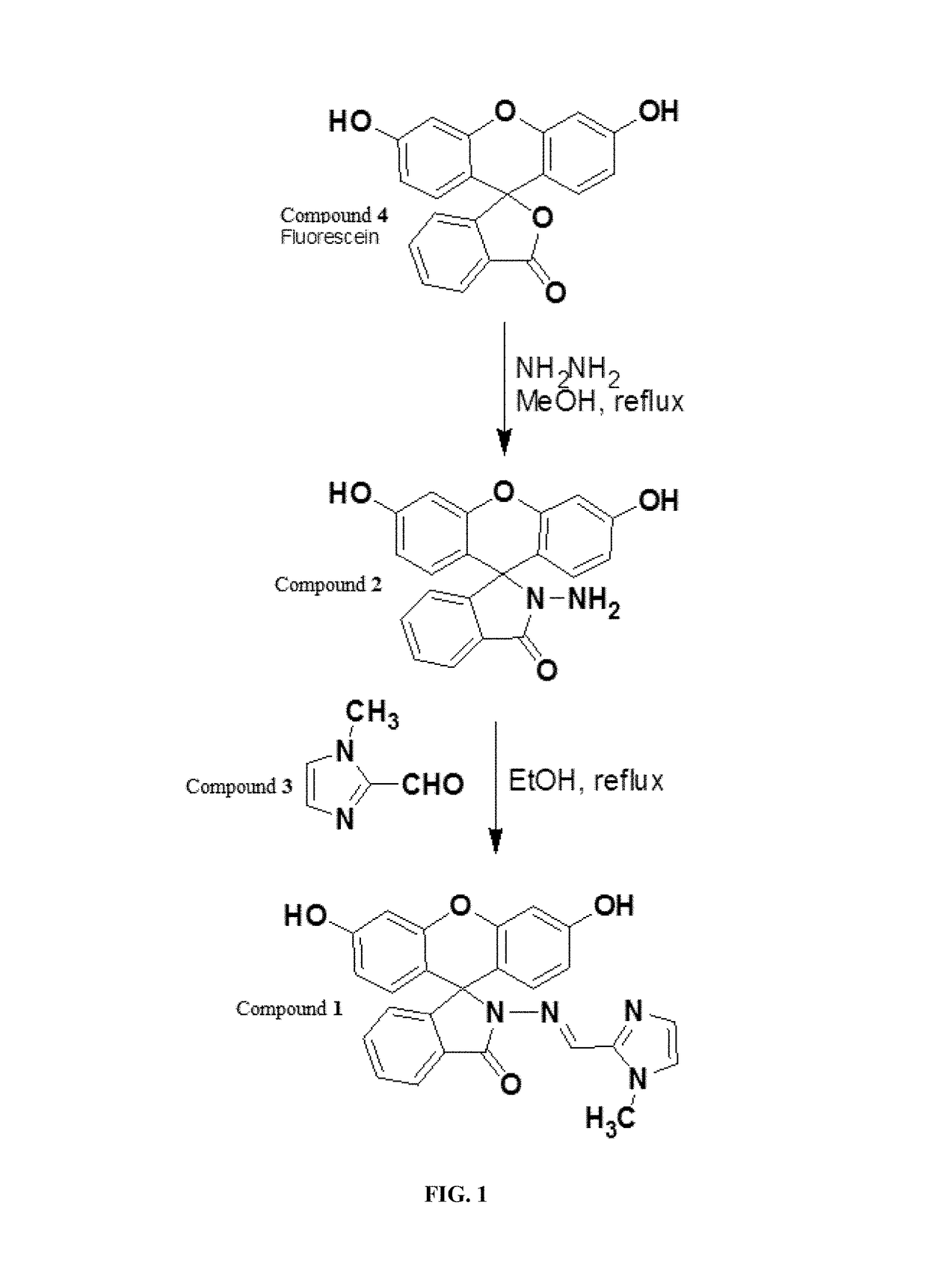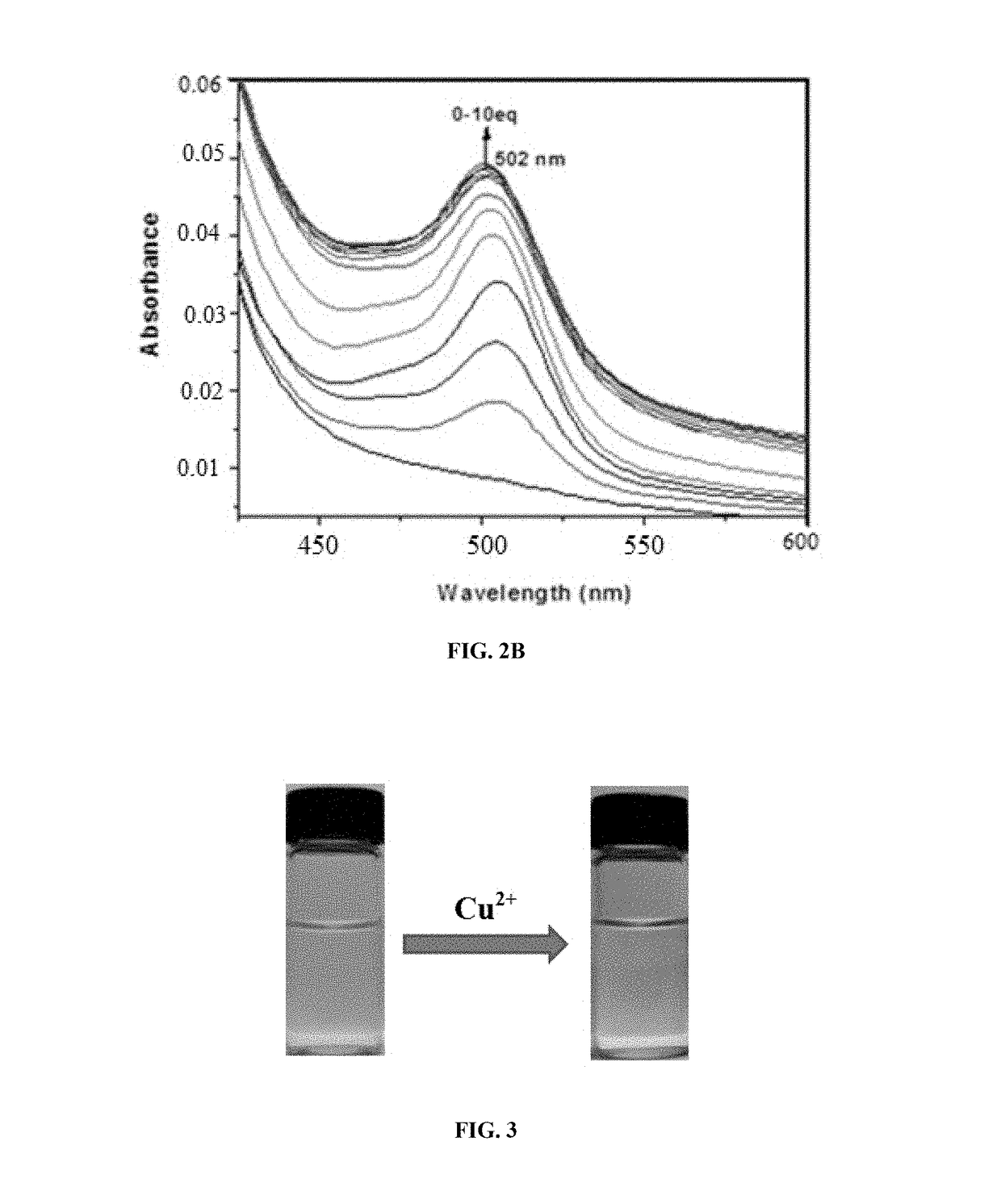Fluorescent schiff base conjugate cu(II) chemosensors and methods thereof
a technology of fluorescent schiff base and conjugate cu(ii) chemosensor, which is applied in the direction of material analysis, material testing goods, instruments, etc., can solve the problems of high cost and complexity of copper screening, x-ray fluorimetry (txrf) and anodic stripping voltammetry (asv), etc., and achieves the effect of simple sample preparation steps, high cost and complexity
- Summary
- Abstract
- Description
- Claims
- Application Information
AI Technical Summary
Benefits of technology
Problems solved by technology
Method used
Image
Examples
example 1
General Methods and Characterization of Prepared Compounds
[0101]Melting points were determined using a Thomas-Hoover capillary melting point apparatus and are uncorrected. 1H and 13C NMR spectra were recorded on a Bruker AM-400 spectrometer using Me4Si as the internal standard. UV-vis absorption spectra were determined on a Jasco V-670 spectrophotometer equipped with a xenon discharge lamp and 1 cm quartz cells. All of the measurements were carried out at 298 K.
[0102]Analytical grade absolute ethanol and methanol were purchased from Merck. Deionized water (double distilled) was used throughout the experiments as an aqueous layer. All other materials used for synthesis were purchased from Aldrich Chemical Co. and used as received without further purification. The N-methylimidazole-2-carbaldehyde (Compound 3) was prepared in accordance with literature procedures [Fasil, A.; Abebe, C.; Eribal, S.; Ramakrishna, G.; Sinn, E. Tetrahedron Lett. 2011, 52 5554.; and Sivaraman, G.; Chellappa,...
example 2
[0103]Synthesis of fluorescein-N-methylimidazole conjugate (Compound 1)
[0104]Fluorescein-N-methylimidazole conjugate compound 1 was designed to bind metal ions via the carbonyl oxygen, imino nitrogen groups and the imidazole nitrogen atoms as donors. FIG. 1 outlines the primary scheme for the syntheses of compound 1 from the reaction of fluorescein hydrazide compound 2 with N-methylimidazole-2-carbaldehyde compound 3 in ethanol. The synthesis of fluorescein hydrazide compound 2 was carried out by reacting fluorescein compound 4 with hydrazine (NH2NH2) in methanol under reflux conditions. The synthesis of N-methylimidazole-2-carbaldehyde compound 3 was carried out according to procedures reported in the literature [Fasil, A.; Abebe, C.; Eribal, S.; Ramakrishna, G.; Sinn, E. Tetrahedron Lett. 2011, 52 5554.; and Sivaraman, G.; Chellappa, D. J Mater. Chem. B 2013, 1, 5768.; and Ding, J.; Yuan, L.; Gao, L.; Chen, J. J Lumin. 2012, 132, 1987.; and Sivaraman, G.; Sathiyaraja, V.; Chellapp...
example 3
[0106]Synthesis of fluorescein-N-methylimidazole conjugate (1) Cu2+ complex
[0107]A mixture of fluorescein-N-methylimidazole conjugate compound 1 (100 mg, 0.23 mmol) and Cu(NO3)2.H2O (62 mg, 0.28 mmol) in methanol was refluxed for 8 hours. The mixture was cooled to room temperature and the precipitated complex was filtered. The filtered cake was washed thoroughly with water, ethanol, and dried under vacuum to provide the complex (95 mg, 82% yield). HR-FAB Mass: calcd for (C25H18O4N4.Cu) 501.0624; found: 501.0621.
PUM
| Property | Measurement | Unit |
|---|---|---|
| excitation wavelength | aaaaa | aaaaa |
| excitation wavelength | aaaaa | aaaaa |
| excitation wavelength | aaaaa | aaaaa |
Abstract
Description
Claims
Application Information
 Login to View More
Login to View More - R&D
- Intellectual Property
- Life Sciences
- Materials
- Tech Scout
- Unparalleled Data Quality
- Higher Quality Content
- 60% Fewer Hallucinations
Browse by: Latest US Patents, China's latest patents, Technical Efficacy Thesaurus, Application Domain, Technology Topic, Popular Technical Reports.
© 2025 PatSnap. All rights reserved.Legal|Privacy policy|Modern Slavery Act Transparency Statement|Sitemap|About US| Contact US: help@patsnap.com



